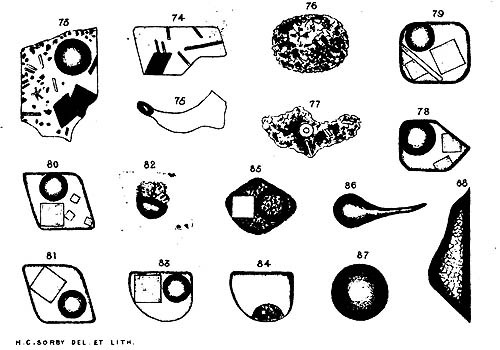Inclusion (mineral) on:
[Wikipedia]
[Google]
[Amazon]

 In
In

 Inclusions are one of the most important factors when it comes to gem valuation. In many gemstones, such as
Inclusions are one of the most important factors when it comes to gem valuation. In many gemstones, such as
File:Gem with inclusion.JPG, Clear gemstone with metallic inclusion.
File:Peridotgem.JPG, Peridot with milky inclusion.
File:Ruby gem.JPG, Natural ruby with inclusions.

 In
In mineralogy
Mineralogy is a subject of geology specializing in the scientific study of the chemistry, crystal structure, and physical (including optical) properties of minerals and mineralized artifacts. Specific studies within mineralogy include the proce ...
, an inclusion is any material that is trapped inside a mineral
In geology and mineralogy, a mineral or mineral species is, broadly speaking, a solid chemical compound with a fairly well-defined chemical composition and a specific crystal structure that occurs naturally in pure form.John P. Rafferty, ed. (2 ...
during its formation. In gemology
Gemology or gemmology is the science dealing with natural and artificial gemstone materials. It is a geoscience and a branch of mineralogy. Some jewelers (and many non-jewelers) are academically trained gemologists and are qualified to identif ...
, an inclusion is a characteristic enclosed within a gemstone, or reaching its surface from the interior.
According to Hutton's law of inclusions, fragments included in a host rock are older than the host rock itself.
Mineralogy
Inclusions are usually other minerals or rocks, but may also be water, gas orpetroleum
Petroleum, also known as crude oil, or simply oil, is a naturally occurring yellowish-black liquid mixture of mainly hydrocarbons, and is found in geological formations. The name ''petroleum'' covers both naturally occurring unprocessed crud ...
. Liquid or vapor inclusions are known as fluid inclusions. In the case of amber
Amber is fossilized tree resin that has been appreciated for its color and natural beauty since Neolithic times. Much valued from antiquity to the present as a gemstone, amber is made into a variety of decorative objects."Amber" (2004). In M ...
it is possible to find insects and plants as inclusions.
The analysis of atmospheric gas bubble
Bubble, Bubbles or The Bubble may refer to:
Common uses
* Bubble (physics), a globule of one substance in another, usually gas in a liquid
** Soap bubble
* Economic bubble, a situation where asset prices are much higher than underlying fund ...
s as inclusions in ice core
An ice core is a core sample that is typically removed from an ice sheet or a high mountain glacier. Since the ice forms from the incremental buildup of annual layers of snow, lower layers are older than upper ones, and an ice core contains ...
s is an important tool in the study of climate change
In common usage, climate change describes global warming—the ongoing increase in global average temperature—and its effects on Earth's climate system. Climate change in a broader sense also includes previous long-term changes to ...
.
A xenolith
A xenolith ("foreign rock") is a rock fragment ( country rock) that becomes enveloped in a larger rock during the latter's development and solidification. In geology, the term ''xenolith'' is almost exclusively used to describe inclusions in ig ...
is a pre-existing rock which has been picked up by a lava flow. Melt inclusions form when bits of melt become trapped inside crystals as they form in the melt.
Gemology

 Inclusions are one of the most important factors when it comes to gem valuation. In many gemstones, such as
Inclusions are one of the most important factors when it comes to gem valuation. In many gemstones, such as diamonds
Diamond is a solid form of the element carbon with its atoms arranged in a crystal structure called diamond cubic. Another solid form of carbon known as graphite is the chemically stable form of carbon at room temperature and pressure, ...
, inclusions affect the clarity of the gem, diminishing the value. In some gems, however, such as star sapphires, the inclusion actually increases the value of the gem.
Many colored gemstones are expected to have inclusions, and the inclusions do not greatly affect the stone's value. Colored gemstones are categorized into three types as follows:
*Type I colored gems include gems with very little or no inclusions. They include aquamarines, topaz
Topaz is a silicate mineral of aluminium and fluorine with the chemical formula Al Si O( F, OH). It is used as a gemstone in jewelry and other adornments. Common topaz in its natural state is colorless, though trace element impurities can mak ...
and zircon
Zircon () is a mineral belonging to the group of nesosilicates and is a source of the metal zirconium. Its chemical name is zirconium(IV) silicate, and its corresponding chemical formula is Zr SiO4. An empirical formula showing some of t ...
.
*Type II colored gems include those that often have a few inclusions. They include sapphire
Sapphire is a precious gemstone, a variety of the mineral corundum, consisting of aluminium oxide () with trace amounts of elements such as iron, titanium, chromium, vanadium, or magnesium. The name sapphire is derived via the Latin "sa ...
, ruby
A ruby is a pinkish red to blood-red colored gemstone, a variety of the mineral corundum ( aluminium oxide). Ruby is one of the most popular traditional jewelry gems and is very durable. Other varieties of gem-quality corundum are called ...
, garnet
Garnets () are a group of silicate minerals that have been used since the Bronze Age as gemstones and abrasives.
All species of garnets possess similar physical properties and crystal forms, but differ in chemical composition. The different ...
and spinel
Spinel () is the magnesium/aluminium member of the larger spinel group of minerals. It has the formula in the cubic crystal system. Its name comes from the Latin word , which means ''spine'' in reference to its pointed crystals.
Properties
S ...
.
*Type III colored gems include those that almost always have inclusions. Gems in this category include emerald
Emerald is a gemstone and a variety of the mineral beryl (Be3Al2(SiO3)6) colored green by trace amounts of chromium or sometimes vanadium.Hurlbut, Cornelius S. Jr. and Kammerling, Robert C. (1991) ''Gemology'', John Wiley & Sons, New York, p ...
and tourmaline
Tourmaline ( ) is a crystalline Silicate mineral, silicate mineral group in which boron is compounded with elements such as aluminium, iron, magnesium, sodium, lithium, or potassium. Tourmaline is a gemstone and can be found in a wide variety o ...
.
Metallurgy
The term "inclusion" is also used in the context of metallurgy and metals processing. During the melt stage of processing particles such as oxides can enter or form in the liquid metal which are subsequently trapped when the melt solidifies. The term is usually used negatively such as when the particle could act as a fatigue crack nucleator or as an area of high stress intensity.See also
*Diamond inclusions
Diamond inclusions are the non-diamond materials that get encapsulated inside diamond during its formation process in the mantle. The trapped materials can be other minerals or fluids like water. Since diamonds have high strength and low reactivi ...
References
{{reflist Mineralogy Petrology Gemology Metallurgy